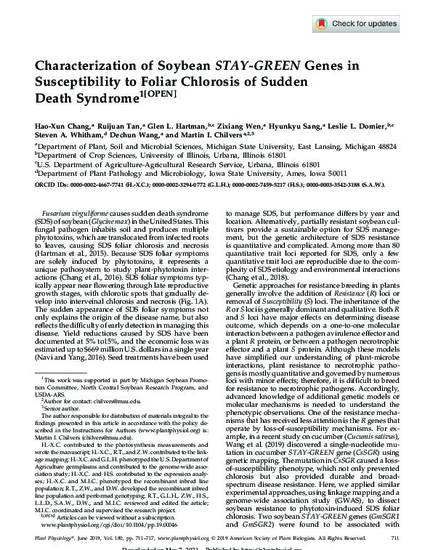
Fusarium virguliforme causes sudden death syndrome (SDS) of soybean (Glycine max) in the United States. This fungal pathogen inhabits soil and produces multiple phytotoxins, which are translocated from infected roots to leaves, causing SDS foliar chlorosis and necrosis (Hartman et al., 2015). Because SDS foliar symptoms are solely induced by phytotoxins, it represents a unique pathosystem to study plant-phytotoxin interactions (Chang et al., 2016). SDS foliar symptoms typically appear near flowering through late reproductive growth stages, with chlorotic spots that gradually develop into interveinal chlorosis and necrosis (Fig. 1A). The sudden appearance of SDS foliar symptoms not only explains the origin of the disease name, but also reflects the difficulty of early detection in managing this disease. Yield reductions caused by SDS have been documented at 5% to15%, and the economic loss was estimated up to $669 million U.S. dollars in a single year (Navi and Yang, 2016). Seed treatments have been used to manage SDS, but performance differs by year and location. Alternatively, partially resistant soybean cultivars provide a sustainable option for SDS management, but the genetic architecture of SDS resistance is quantitative and complicated. Among more than 80 quantitative trait loci reported for SDS, only a few quantitative trait loci are reproducible due to the complexity of SDS etiology and environmental interactions (Chang et al., 2018).
Available at: http://works.bepress.com/steven-whitham/56/

This article is published as Chang, Hao-Xun, Ruijuan Tan, Glen L. Hartman, Zixiang Wen, Hyunkyu Sang, Leslie L. Domier, Steven A. Whitham, Dechun Wang, and Martin I. Chilvers. "Characterization of soybean STAY-GREEN genes in susceptibility to foliar chlorosis of sudden death syndrome." Plant physiology 180 (2019): 711-717. doi:10.1104/pp.19.00046.